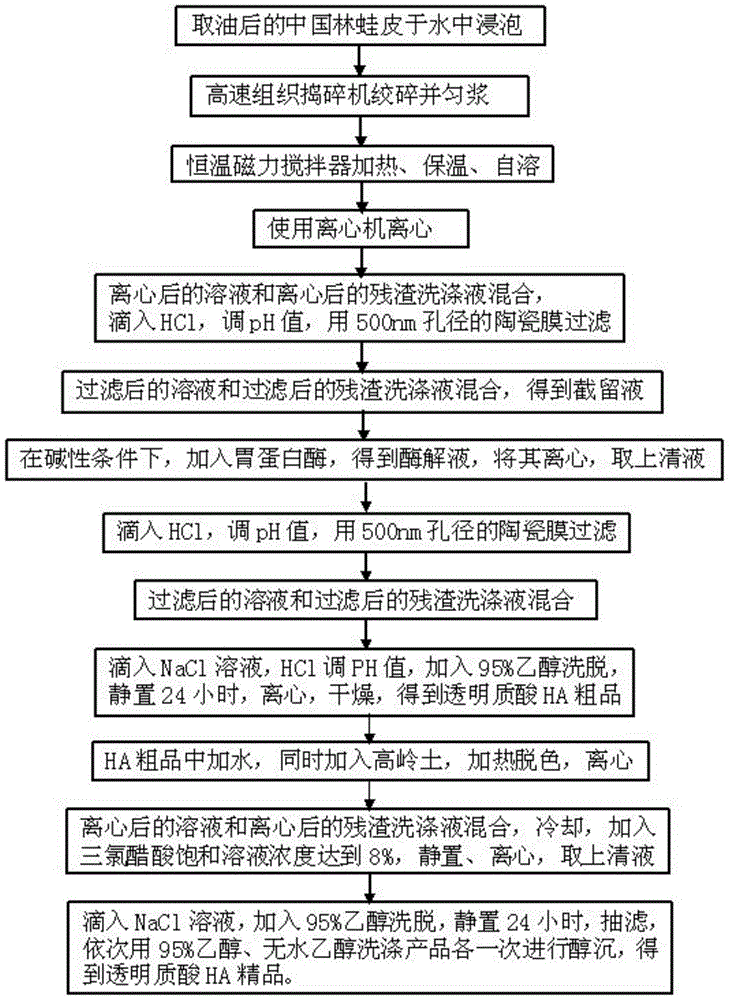Method for Separating and Extracting Hyaluronic Acid from Chinese Rana Skin by Membrane Filtration
A hyaluronic acid and membrane filtration technology, which is applied in the field of separation and extraction of hyaluronic acid, can solve the problems of reagent residue, inability to effectively remove protein, and reduced safety, and achieve high yields
- Summary
- Abstract
- Description
- Claims
- Application Information
AI Technical Summary
Problems solved by technology
Method used
Image
Examples
Embodiment l
[0030] Embodiment 1, select the Chinese wood frog skin after getting the oil, the Chinese wood frog skin is lower in fat content and easily minced, therefore, directly add the Chinese wood frog skin 8 times of water and soak for 20 hours. Homogenize at 10,000 r / min for 2 minutes. After homogenization, it becomes a paste. Stir and heat to 85°C for 5 minutes. Cool to 45°C. Wash the residue twice.
[0031] HCl adjusted to pH 1.5, 500nm pore size ceramic membrane filtration, 9 times the amount of water was added for 3 washes, retentate, alkaline conditions (pH 7.5), pepsin (amount: 45mg / g dry tissue) enzymatic hydrolysis at 50 ° C for 12 After 1 hour, the enzymatic hydrolyzed solution was centrifuged to get the clear liquid, HCl was adjusted to pH 1.5, 500nm pore size ceramic membrane was filtered, 30 times the amount of water was added for 10 washings, NaCl was added to make the concentration of NaCl in the solution 0.1mol / L, and HCl was adjusted to pH 6.5 , add 3 times the volu...
Embodiment 2
[0033] Example 2. Select the Rana chinensis skin after oil extraction. The Rana chinensis skin has low fat content and is easy to be minced. Therefore, directly add 10 times the amount of water for 24 hours. Homogenize at 12,000 rpm for 3 minutes. After homogenization, it becomes a paste. Stir and heat to 90 °C, keep warm for 10 min, cool to 50 °C, autolyse for 12 hours, centrifuge at 4,000 rpm, 4 times the volume of water, and divide Wash the residue twice.
[0034]HCl adjusted to pH 2.0, 500nm pore size ceramic membrane filtration, 9 times the amount of water was added for 3 washings, retentate, alkaline conditions (pH 8.5), pepsin (amount: 40 mg / g dry tissue) enzymatic hydrolysis at 50 ° C for 12 After 1 hour, the enzymatic hydrolyzed solution was centrifuged to get the clear liquid, HCl was adjusted to pH 2.0, 500nm pore size ceramic membrane was filtered, 30 times of water was added for 10 times to wash, and NaCl was added to make the concentration of NaCl in the solution...
Embodiment 3
[0036] Example 3. Select the Rana chinensis skin after oil extraction. The Rana chinensis rind has a low fat content and is easy to be minced. Therefore, directly add 12 times the amount of water to soak for 28 hours. Homogenize at 14,000 rpm for 4 minutes. After homogenization, it becomes a paste. Stir and heat to 95°C, keep warm for 15 minutes, cool to 55°C, autolyse for 12 hours, centrifuge at 4,000 rpm, and 4 times the volume of water. Wash the residue twice.
[0037] HCl adjusted to pH 2.5, 500nm pore size ceramic membrane filtration, 9 times the amount of water was added for 3 washings, retentate, alkaline conditions (pH 8.0), pepsin (amount: 50mg / g dry tissue) enzymatic hydrolysis at 50 ° C for 12 hours, the enzymatic hydrolyzate was centrifuged to get the clear liquid, HCl was adjusted to pH 2.5, filtered with a 500nm pore size ceramic membrane, 30 times the amount of water was added for 10 washings, and NaCl was added to make the concentration of NaCl in the solution ...
PUM
| Property | Measurement | Unit |
|---|---|---|
| molecular weight | aaaaa | aaaaa |
| molecular weight | aaaaa | aaaaa |
| pore size | aaaaa | aaaaa |
Abstract
Description
Claims
Application Information
 Login to View More
Login to View More - R&D
- Intellectual Property
- Life Sciences
- Materials
- Tech Scout
- Unparalleled Data Quality
- Higher Quality Content
- 60% Fewer Hallucinations
Browse by: Latest US Patents, China's latest patents, Technical Efficacy Thesaurus, Application Domain, Technology Topic, Popular Technical Reports.
© 2025 PatSnap. All rights reserved.Legal|Privacy policy|Modern Slavery Act Transparency Statement|Sitemap|About US| Contact US: help@patsnap.com

